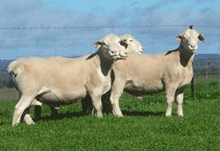Australian Dorper Notes
The concept of Australian Dorper Notes is to bring together into one place, a quantity of information, which may be useful to the breeders of Australian Dorpers and White Dorpers. It is a body of information which will be updated and added to over time as new developments in the sheep industry occur and circumstances change.

The Australian Dorper and White Dorper Association Inc. acknowldges the the work of and is indebted to the many people who have contributed to this body of information. In particular we would like to thank those producers and researchers who have given their time to share their knowledge with us. Thanks should also go to external bodies such as State Departments of Agriculture and Meat and Livestock Australia who have allowed us to include their information under Australian Dorper Notes.
Table of Contents
A. Industry Background
B. Management
C. Nutrition
D. Animal Health
E. Breeding & Genetics
F. Meat Production & Marketing
G. Compliance for the Australian Sheep Industry

B. Management
B2. How to Tell The Age Of Sheep
B3. Age of First Joining Sheep
B4. Ewe Management and Body Weight at Joining
B5. Fat score of Ewes at Joining: The Benefits of Optimal Nutrition
B6. Why Fat score Breeding Ewes?
B7. The Economics of Managing Breeding Ewes
B8. Lambing and difficult births (Dystocia)
C. Nutrition
C1. How Pasture characteristics Influence Sheep Production
C2. Grazing and Pasture Management
C3. Feeding, Finishing & Nutrition
C4. Full Hand feeding of Sheep: Feeding Management
C5. Full Hand feeding of Sheep: Management
C6. Full Hand feeding of Sheep: Quantities
C7. Quick Facts - Lamb Feedlot Nutrition
D. Animal Health
D1. Vaccinating
D2. Cheesy gland (Caseous Lymphadenitis) in Sheep
D3. Sheep Health: Scabby Mouth
D4. Internal Parasites in Sheep
D5. Registered drenches for Sheep Worms
D6. Drench Resistance and Sheep Worm Control
D7. Laboratory Tests for Worms: Parasitology
D8. Quarantine Drenching: Don't Import Resistant Sheep Worms
D9. WormTest for Livestock and Guide to Egg Counts
D10. Sheep Drench Combinations, Resistance and 'Refugia'
D11. Liver Fluke: The Basics
D12. Selenium Deficiency in Sheep
D13. Hypocalcaemia in Sheep (Milk Fever)
D14. Goitre and Iodine Deficiency
D15. Lamb autopsy: notes on a procedure for determining cause of death
D16. Photosensitisation in stock
D17. Lameness in Sheep
D18. Foot abscess in sheep
D19. Bloat
D20. Grain poisoning of cattle and sheep
D21. Pregnancy Toxaemia (twin lamb disease)
D22. Perennial Ryegrass Staggers
D23. Ovine Brucellosis
D24. Ovine Brucellosis – Reducing the Risk
D25. Ovine Johne's Disease (OJD)
D26. OJD Prevalence Areas from 1 January 2011 onwards
E. Breeding & Genetics
F. Meat Production & Marketing
F1. Comparing lamb marketing methods
F2. Preparation for Marketing animals
F3. Latest Market Prices and Indicators for Sheep
F4. Onling Marketing of Livestock, see also
F5. Getting Started with AuctionsPlus (link to AuctionsPlus site)
F6. Livestock Exports
G. Compliance for the Australian Sheep Industry
G1. Property Identification Codes (PICs) Explained
G2. NLIS for Sheep and Goats- Basic Information
G3. Types of NLIS Tags
G4. Accredited NLIS Sheep and Goat Tags
G5. How to Order NLIS Sheep and Goat Tags
G6. Sheep Movement Documentation
G7. Sheep Health Statement Information
G8. On-farm assurance, identification & traceability